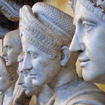Scientists
Upper-Intermediate Level level
Description
Materials
Main Aims
-
For the students to practice speaking for fluency in the context of science.
Subsidiary Aims
-
To provide clarification of passive voice in the context of science
Procedure (39-51 minutes)
- T displays (slide1) containing names of female inventors and scientists. T asks the Ss to match them with their inventions/discoveries. Ss do so in pairs/groups in breakout rooms. - T monitors the students as they discuss. T could move some students to other groups in case T feels it is needed for more interaction.
-T displays (slide2) showing a picture. T tries to set up a context of the picture so Ss have a clearer image. T tries to elicit the word. T can display the definition/example to help the Ss generate more ideas. T displays the word, reads it, then asks the Ss about the stress, and finally marks the stress and drills it until the Ss fully get it. -T does the same to (slides 3-4-5-6-7-8-9).
-T displays (slide 10) showing some scientific facts and myths that people think are facts. T asks the students to discuss in pears/groups which one they think are true and which aren't. -T sends the Ss to breakout rooms to discuss. T monitors as Ss discuss. T can take some notes in case he/she needs to use some in the feedback. -T listens to Ss and then asks them if they could think of any other myths people think are facts. - T displays (slide 11) containing a chart of some scientific family words. T asks the students to figure them out in pairs/groups. T gives some time for the Ss to do so in breakout rooms. -T monitors as Ss as they fill in the gaps and discuss the stress pattern. -T asks the students what they found. T confirms the answers as Ss say them. -T asks the students about the stress of the tricky ones. (T could reveal the answers to Ss to check in case he/she needs time) -T makes sure that the Ss got the idea of stress shift in family words.
-T displays (slide12) containing some prompting questions for the Ss. -T asks the students to take a look at the questions to confirm they got them. T asks the Ss to grab a piece of paper and a pen. -T asks the students to interview their partners and write the answers they get from them. T tells the Ss to mingle once they get enough information from that partner (T needs to take care of mingling). -T monitors the Ss as they interview without interruption unless the Ss need help. -T takes notes as s/he monitors, to use them for the feedback.
-T listens to Ss for feedback. T prompts the Ss to speak in case they need it. -T uses finger correction if needed.
-T displays (slide 14) containing a prompting request. -T asks the students to think of an inventor/scientist they know and like. - Ss try to think and tell T and Ss about him/her (including his impact on the world/ inventions).

